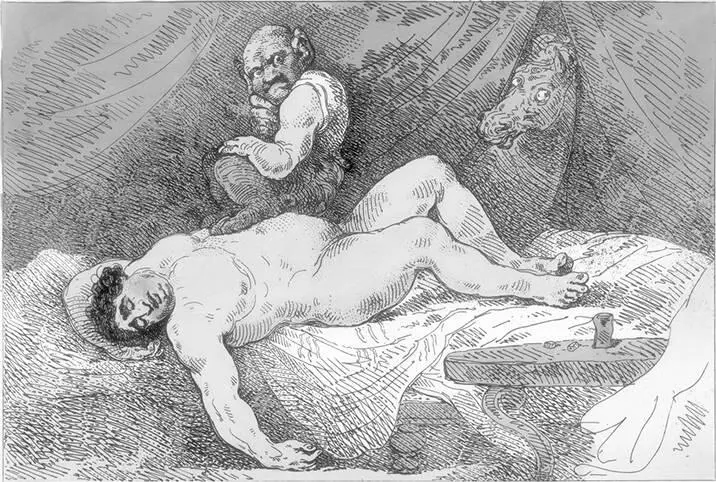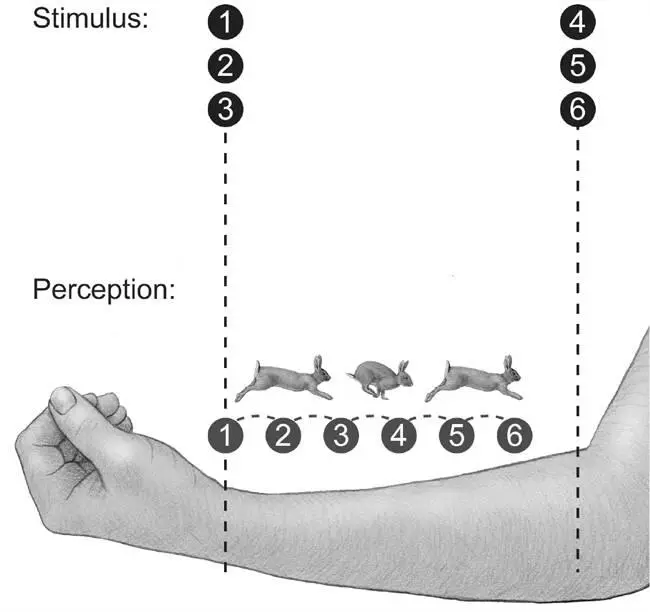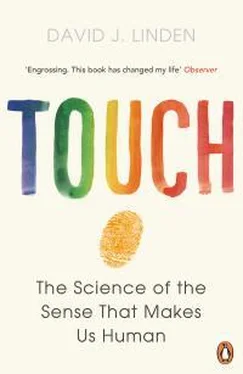The flaccid paralysis that occurs during REM sleep gives rise to another phenomenon. While most people recover voluntary control of their muscles quickly upon waking from REM sleep, some experience a period of tens of seconds or even minutes between the moment they awaken from REM and the time when the blockade of motor signals to the spinal cord is finally relieved. In this situation, people are awake but temporarily paralyzed. When their commands to move are generated, there are no corresponding touch or proprioceptive feedback signals, so the brain makes the inference that there must be a crushing weight on the body that prevents movement. This terrifying tactile hallucination is fairly common 11and has likely influenced folk tales of chest- and abdomen-compressing malevolent sleep demons that are found in many cultures (figure 8.1).

Figure 8.1A male sleep demon, called an incubus, applies his weight to the abdomen of a sleeper. In many traditions it is believed that sexual intercourse with an incubus can result in ill health or even death. The folk tale of the incubus (and its female counterpart, the succubus) may derive in part from the phenomenon of sleep paralysis, in which waking from a narrative dream is accompanied by the sensation of a crushing weight. This etching, called The Covent Garden Night Mare , was made by Thomas Rowlandson in 1784. It is a satiric adaptation of a well-known painting, The Nightmare by Henry Fuseli (1781). The original version features an attractive young woman, replaced here by the British politician Charles James Fox. Used with permission of the City of Westminster Archives Center.

Sensory illusions can also be fun and can provide a glimpse behind the curtain to reveal the brain’s subconscious perceptual strategies. There are many illusions in the domain of touch, and my favorite is called the cutaneous rabbit. 12If you were to close your eyes and then I were to give six quick taps to your inner forearm with equal time intervals between the taps, delivering the first three to your wrist and the second three to your inner elbow, you would feel the first tap at your wrist, but the subsequent five would appear to hop along the intervening unstimulated skin in the direction of your elbow (figure 8.2). We know that this effect is produced in the brain, not by some mechanical effect on the skin, because the rabbit hops are felt even when the intervening area of skin is anesthetized. Furthermore, when the cutaneous rabbit illusion is performed on a subject in a brain scanner, the pattern of activation matches the illusory experience: Hopping activation in the intervening sites along the map of the arm is observed in the somatosensory cortex. 13
While we don’t fully understand the neural basis of the cutaneous rabbit illusion, the best overall hypothesis involves expectation. Either through our individual experience in the world or through the genetically encoded experience of the human species, we have come to expect that tapping stimuli typically progress slowly along the skin. As a consequence, when there is a large spatial gap between taps three and four, the sensation of taps four through six is blended with the expectation that these types of signals move slowly. The resultant perception of a tap at an intervening location between elbow and wrist is the brain’s inference: a sort of compromise between the touch signals it receives from skin at the elbow and a prior expectation of slow movement. What’s even odder is that the perception of taps two and three are also altered. This effect is called postdiction, and it relies upon the short delay (about 0.2 second) between the time the tap is received on the skin and when it is perceived. During that perceptual delay, the brain can modulate touch processing based upon the continuing inflow of information blended with expectation to reach back in time and change the perception of events that just occurred. 14

Figure 8.2The cutaneous rabbit illusion. Three taps at the wrist followed quickly by three taps at the elbow are perceived as a tap at the wrist followed by progressive hops of the tap stimulus along the forearm.
Our brains naturally bind together information from multiple senses to create a holistic perception of events and objects. Prior expectation can also create illusions when touch sensation is coincident with another sensory stimulus, such as sound. For example, when you rub your palms together like an old-fashioned movie villain plotting a caper, you are simultaneously feeling the sensations on your palmar skin and hearing the whispery noise that results. In one clever experiment subjects were instructed to rub their palms together while a nearby microphone picked up the resultant sounds, which were played back to the subject through headphones. In some trials the sound through the headphones was unaltered, but in others it was modified to boost the high-frequency audio components, which made the subjects perceive their skin as smoother and drier—more like paper. Hence, the name of this effect: the parchment-skin illusion. When an electronic circuit was used to delay the audio feedback by one-tenth of a second, the illusion failed, and the subjects’ skin felt normal. In order for the brain to translate high-frequency sound into the perception of smoother, drier skin, the sound must appear to result from the action of the palms rubbing together. 15
In 1846 Ernst Weber, one of the founders of modern psychology, reported that a large cold coin (a Prussian silver thaler) placed on the forehead feels much heavier than a warm one. It’s a significant effect: Most subjects in the experiment perceived the cold coin as being fourfold heavier than the warm one. A similar result occurred when the coin was placed on the forearm. 16Generally speaking, we don’t automatically expect cold objects to be heavier, so the most likely explanation for the effect lies in the sensory nerves, not the brain. Many of the Merkel disk sensory neurons (which respond persistently to pressure) are also activated by sudden cooling of the skin, 17and it is this activation that is likely to underlie the temperature-weight illusion. The take-home message: Not all tactile illusions result from prior expectations (or any process in the brain at all). They can also arise simply from the tuning of sensory neurons in the skin.

Now let’s move from the illusory to the transcendent. A few months ago I was holding Z. and her skin felt wonderful—not just soft and warm, but electric and glowing. At one point we were touching each other on the arms, neck, and back, and the sensation was truly amazing: We could both feel the electrical hum of loving attraction. A few minutes later, while continuing to touch and talk, we had a minor disagreement, a mere ripple in an otherwise tranquil and sweet interlude. The slight rift ended after only a few minutes, and when we were back to feeling close, she asked, “Did you notice how different our touching felt as soon as the mood changed? It was something subtle about skin texture that changed the touch from electric to ordinary. And then later, when it was resolved, did you feel that electric vibe come back?” I had indeed.
Nearly everyone has experienced that wonderful, connected sensation of loving touch. How can we understand it in terms of neurobiology? It’s not just a matter of such sensory properties as soft, warm, and yielding. After all, cuddling with your cat is delightful, and it can sometimes be even softer and warmer than your human partner, but that romantic glow just isn’t there. 18Certainly a large part of the loving-touch sensation can be explained by emotional and cognitive modulation of touch perception within the brain. We’ve discussed how these states can affect perception of pain, so it’s not too surprising that they can also affect other touch sensations. But the loving-touch vibe cannot be explained solely by events in the brain.
Читать дальше















